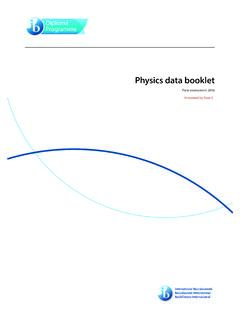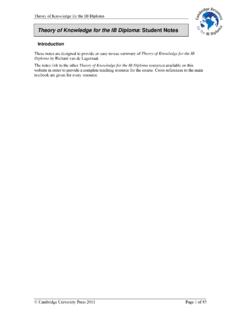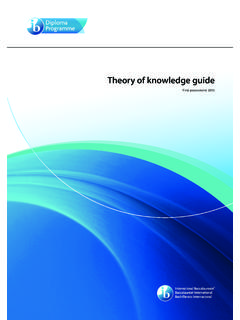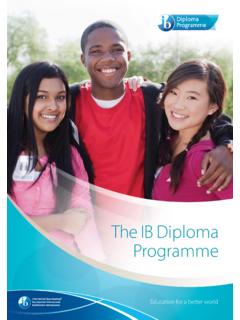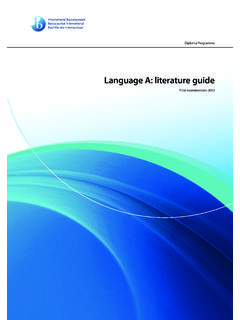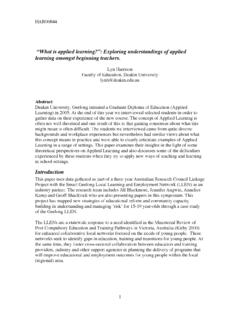Transcription of Physics guide
1 Physics guide First assessment 2016. Physics guide First assessment 2016. Diploma Programme Physics guide Published February 2014. Published on behalf of the international baccalaureate Organization, a not-for-profit educational foundation of 15 Route des Morillons, 1218 Le Grand-Saconnex, Geneva, Switzerland by the international baccalaureate Organization (UK) Ltd Peterson House, Malthouse Avenue, Cardiff Gate Cardiff, Wales CF23 8GL. United Kingdom Website: international baccalaureate Organization 2014. The international baccalaureate Organization (known as the IB) offers four high-quality and challenging educational programmes for a worldwide community of schools, aiming to create a better, more peaceful world.
2 This publication is one of a range of materials produced to support these programmes. The IB may use a variety of sources in its work and checks information to verify accuracy and authenticity, particularly when using community-based knowledge sources such as Wikipedia. The IB respects the principles of intellectual property and makes strenuous efforts to identify and obtain permission before publication from rights holders of all copyright material used. The IB is grateful for permissions received for material used in this publication and will be pleased to correct any errors or omissions at the earliest opportunity. All rights reserved.
3 No part of this publication may be reproduced, stored in a retrieval system, or transmitted, in any form or by any means, without the prior written permission of the IB, or as expressly permitted by law or by the IB's own rules and policy. See IB merchandise and publications can be purchased through the IB store at Email: international baccalaureate , Baccalaur at international and Bachillerato Internacional are registered trademarks of the international baccalaureate Organization. 4076. IB mission statement The international baccalaureate aims to develop inquiring, knowledgeable and caring young people who help to create a better and more peaceful world through intercultural understanding and respect.
4 To this end the organization works with schools, governments and international organizations to develop challenging programmes of international education and rigorous assessment. These programmes encourage students across the world to become active, compassionate and lifelong learners who understand that other people, with their differences, can also be right. Contents Introduction 1. Purpose of this document 1. The Diploma Programme 2. Nature of science 6. Nature of Physics 12. Aims 17. Assessment objectives 18. Syllabus 19. Syllabus outline 19. Approaches to the teaching and learning of Physics 20. Syllabus content 25. Assessment 130.
5 Assessment in the Diploma Programme 130. Assessment outline SL 132. Assessment outline HL 133. External assessment 134. Internal assessment 136. Appendices 154. Glossary of command terms 154. Bibliography 157. Physics guide ix Introduction Purpose of this document This publication is intended to guide the planning, teaching and assessment of the subject in schools. Subject teachers are the primary audience, although it is expected that teachers will use the guide to inform students and parents about the subject. This guide can be found on the subject page of the online curriculum centre (OCC) at , a password-protected IB website designed to support IB teachers.
6 It can also be purchased from the IB store at Additional resources Additional publications such as teacher support materials, subject reports, internal assessment guidance and grade descriptors can also be found on the OCC. Past examination papers as well as markschemes can be purchased from the IB store. Teachers are encouraged to check the OCC for additional resources created or used by other teachers. Teachers can provide details of useful resources, for example: websites, books, videos, journals or teaching ideas. Acknowledgment The IB wishes to thank the educators and associated schools for generously contributing time and resources to the production of this guide .
7 First assessment 2016. Physics guide 1. Introduction The Diploma Programme The Diploma Programme is a rigorous pre-university course of study designed for students in the 16 to 19. age range. It is a broad-based two-year course that aims to encourage students to be knowledgeable and inquiring, but also caring and compassionate. There is a strong emphasis on encouraging students to develop intercultural understanding, open-mindedness, and the attitudes necessary for them to respect and evaluate a range of points of view. The Diploma Programme model The course is presented as six academic areas enclosing a central core (see figure 1).
8 It encourages the concurrent study of a broad range of academic areas. Students study: two modern languages (or a modern language and a classical language); a humanities or social science subject; an experimental science;. mathematics; one of the creative arts. It is this comprehensive range of subjects that makes the Diploma Programme a demanding course of study designed to prepare students effectively for university entrance. In each of the academic areas students have flexibility in making their choices, which means they can choose subjects that particularly interest them and that they may wish to study further at university.
9 Figure 1. Diploma Programme model 2 Physics guide The Diploma Programme Choosing the right combination Students are required to choose one subject from each of the six academic areas, although they can, instead of an arts subject, choose two subjects from another area. Normally, three subjects (and not more than four) are taken at higher level (HL), and the others are taken at standard level (SL). The IB recommends 240. teaching hours for HL subjects and 150 hours for SL. Subjects at HL are studied in greater depth and breadth than at SL. At both levels, many skills are developed, especially those of critical thinking and analysis.
10 At the end of the course, students' abilities are measured by means of external assessment. Many subjects contain some element of coursework assessed by teachers. The core of the Diploma Programme Model All Diploma Programme students participate in the three course elements that make up the core of the model. Theory of knowledge (TOK) is a course that is fundamentally about critical thinking and inquiry into the process of knowing rather than about learning a specific body of knowledge. The TOK course examines the nature of knowledge and how we know what we claim to know. It does this by encouraging students to analyse knowledge claims and explore questions about the construction of knowledge.
